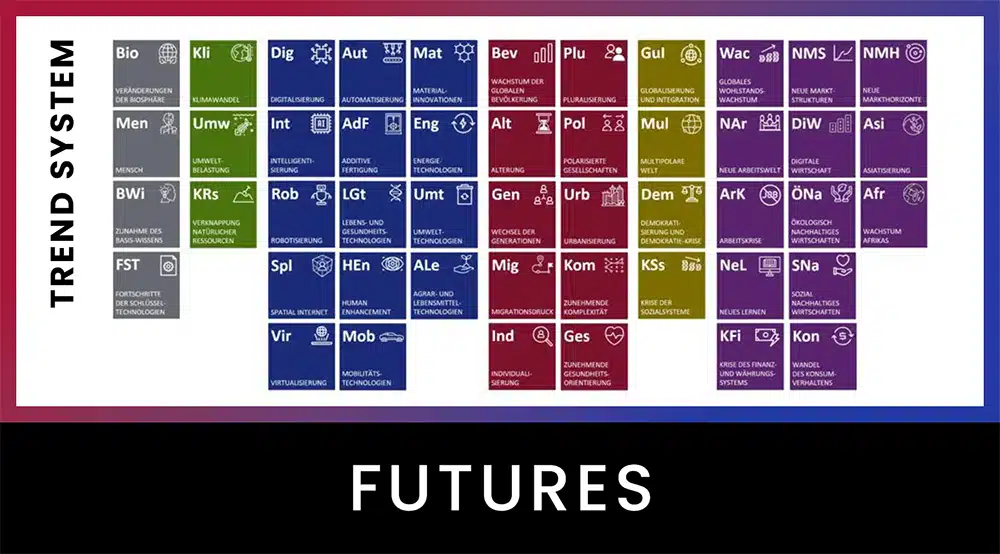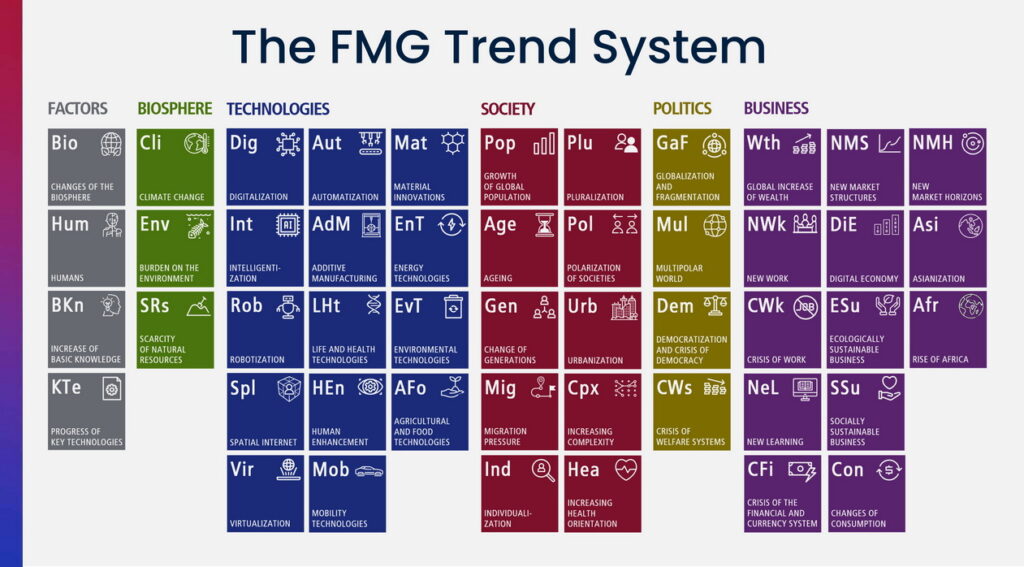Dr. Pero Mićić
A few weeks ago, the Chinese government made a consequential announcement. Which only a few people noticed. It’s about humanoid robots.
Humanoid robots will reshape the world, says the Chinese government in a guideline for their entire economy. China wants to become the world market leader in humanoid robots by 2027. That’s in three years! Is this just science fiction or should we take it seriously? If you produce, transport, sell or manage something physical in your industry, this is an existential question! The answer can be found in this article.
Humanoid robots: what exactly does the Chinese government want?
They want to become the world leader in the mass production of humanoid robots by 2027. We will have a global shortage of up to 100 million workers. And it’s getting worse. You can see this in factories as well as in the trades. China wants to build robots that can quote “think, learn and innovate”. To this end, the Chinese government will consistently invest in the training of experts and provide massive funding and strategic support to robotics companies. By 2027, China wants to have a reliable system of supply chains for humanoid robots. That sounds like China is serious, doesn’t it?
But will humanoid robots really work? Will millions or even billions of them work in factories, serve us in restaurants, make our beds in hotels and load our dishwashers?
Well, BMW has already secured a cooperation with Figure, a US company for humanoid robots.
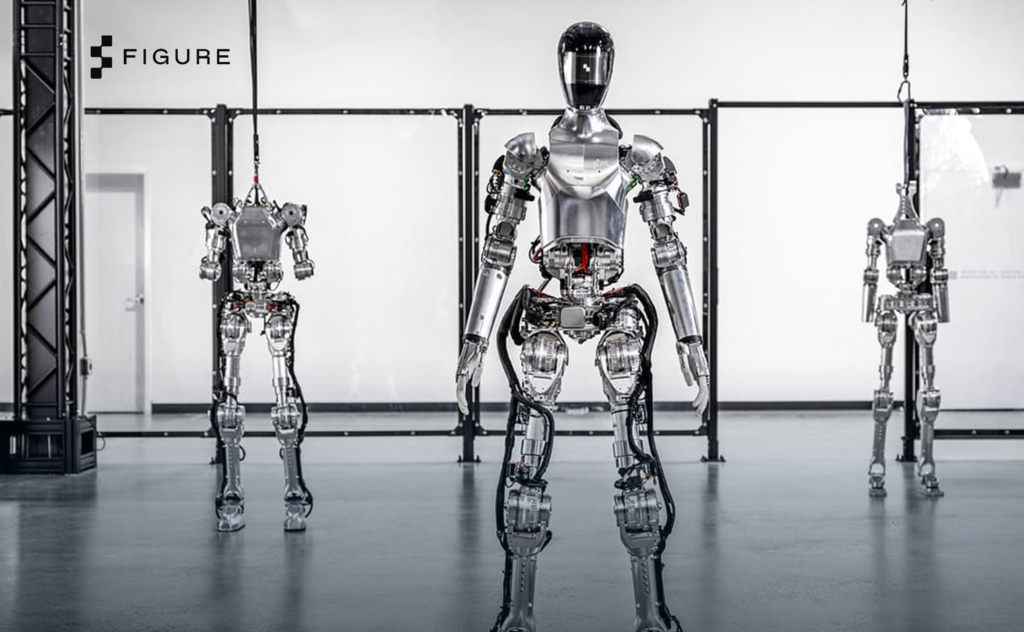
The new wave of humanoid robots
In the last two years, humanoid robots have been popping up everywhere.
Digit from Agility Robotics, Apollo from Apptronik, CyberOne from Xiaomi, H1 from Unitree, PX5 from XPeng, Phoenix from Sanctuary AI, 1X Figure from Figure AI and Optimus from Tesla. These humanoid robots are primarily intended for work that would otherwise be done by humans. First in production and logistics, later in service and finally also in our homes. Unlike industrial robots and warehouse robots, humanoids can work in unstructured environments. A production line is structured. The work of a plumber is largely unstructured, as is housework or gardening.
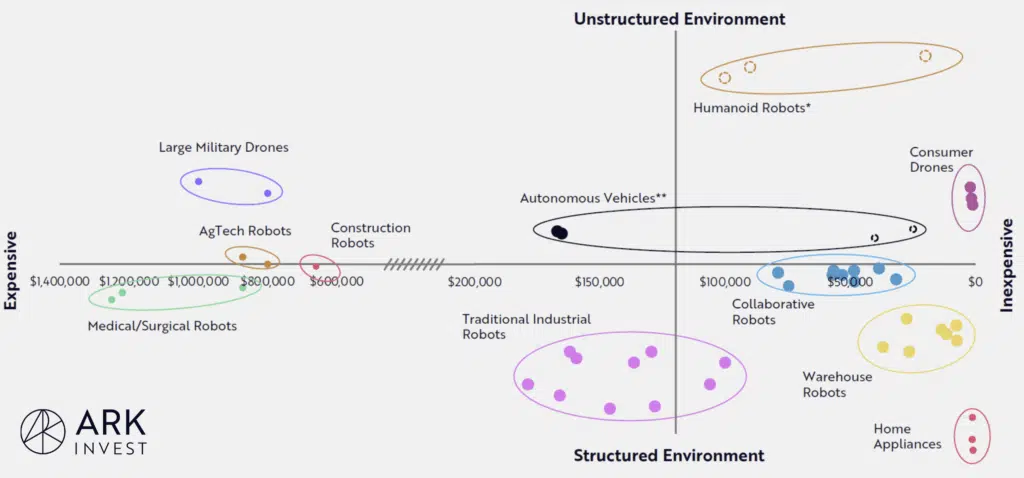
Will the physical capabilities of humanoid robots be sufficient?
will humanoid robots be working for us in the future? Perhaps even millions and billions of them, as some visionaries predict?
Let’s systematically, step by step, come to an assessment.
In this article, I will focus on the physical capabilities of robots. In later posts, we’ll look at cognitive capabilities, societal impact, finances and more. For example, at the question of how you earn your income if the robot takes your job.
First, let’s look at the plus arguments. Plus arguments are in favor of humanoid robots having the physical capabilities to populate the world en masse and work for us.
PLUS arguments: yes
The fine motor skills of humanoid robots are already enormous today
As early as 2016, the robot STAR was able to suture human tissue after surgery better than a human surgeon. There are robots for super microsurgery that operate as well as very few super surgeons. And soon better than them. And much cheaper. At some point, humanoids will also be able to fold origami in the dark.
Dear men: If you have to have a prostate operation, you should preferably do it in a clinic that works with the DaVinci robot. It was approved by the authorities 20 years ago. If surgeons operate without DaVinci, incontinence and impotence are common consequences. Both unpleasant in their own way. Not so with DaVinci. There are far fewer cases of such side effects, which you really don’t want.
OpenAI has developed a robotic hand that can solve the Rubik’s Cube even when people kept interfering with it. That was 2019. Four years is now an eternity in AI and robotics. Tesla recently demonstrated how precisely and carefully Optimus can handle an egg. He or she or it also folds a T-shirt. Although still remote-controlled, the arms and hands are already perfectly suited for this.
Humanoids will soon be physically capable of performing a large proportion of physical tasks. Even as plumbers, painters or landscape gardeners.
Humanoid robots will have much better senses than we do
We humans can perform all our tasks with our five senses. But our senses are limited. We only perceive a small section of reality. Many animals have much more powerful senses. Eagles can see three times more sharply, cats can see 50% better in the dark, dogs can smell at least 10,000 times better and hear many times higher frequencies than humans. Elephants can sense vibrations in the ground over several kilometers.
Some animals have additional senses that we lack completely. Bats and dolphins use echolocation. Snakes can detect a rabbit in the dark using infrared light. Bees, migratory birds and others orient themselves with a magnetic sense. Sharks can perceive the electrical fields of living creatures, even their heartbeat.
Robotic eyes, i.e. cameras with infrared, night vision, thermal imaging and special filters, can see at night and in fog, that alone is far beyond the capabilities of our human eyes. Robots can have 360-degree all-round vision. We do not, obviously. Robots with microphones can hear much better than we can. Robots can have radar and ultrasonic sensors. In China, the so-called “triboelectric effect” has been used for an artificial finger to recognize the material touched with 90 percent accuracy. Unthinkable for humans. All of this shows clearly that robots can process significantly more information about their environment than we humans can. That is a major advantage.
The world is built for a humanoid being
Why are humanoid robots modeled on the human body? Because we have built the whole world for a being with two legs, two arms, a torso and a head. Because this being, the human, can excel in an unlimited number of situations. Because factories, roads and buildings are built for humanoid beings. Whether human or robot. Specialized robots, e.g. for welding, will always be superior in their own discipline. But the versatility of the human body and of humanoid robots is extremely valuable. Humanoids are the Swiss army knives of technology. And of course they can use all the tools that we humans use, from screwdrivers to power tools.
Humanoid robots are multi-talented and multi-taskers
While we humans can usually only perform one or a few activities at world-class level, a humanoid robot can perform all the tasks that any other robot in its series has learned. All we have to do is download the desired skill from a skill store and our robot can do what other robots in Korea or Brazil have learned.
And if the activities do not interfere with each other, robots, unlike us, can even multitask, i.e. perform several complex tasks at the same time. Bake us a perfect cake while empathically teachinig us Spanish vocabulary in the process. We humans only ever believe that we are capable of multitasking. It’s an illusion. Scientifically proven.
Humanoid robots can be deployed in dangerous environments
Humanoid robots do not need air to breathe. Viruses and bacteria cannot harm them. They can continue to work in a pandemic. They can also function in toxic smoke, even in highly radioactive environments, if they are built accordingly. And, of course, robots can be used where the risk of losing human life is very high. For example when rescuing buried victims or defusing bombs. Losing a robot only costs money, losing a human being is not unacceptable.
Humanoid robots will take on unworthy work
We humans are and will remain the pinnacle of evolution. Our limited lifespan and our human dignity should be reason enough that we should not be forced to do the 3D, dull, dirty and dangerous work in this modern world just to earn a living. But we can expect robots to do all this with a clear conscience. I’m sure you realize that humanoids are therefore also ideal soldiers. But that’s a completely different topic. At least wars will hardly cost any human lives.
Humanoid robots break down less frequently
Humanoids don’t get sick, neither physically nor mentally. They don’t hate Mondays, and they don’t prefer short Fridays. They will have fewer accidents at work because they can perceive their surroundings better and faster. If they have a defect, they get replaced by a reserve robot and repaired in the meantime.
Humanoid robots can work much longer
Robots don’t get tired. They obviously don’t need breaks. And no vacation. Nor do they demand a four-day week. Humanoids only need to interrupt their work for charging. And if they are stationary, they can be connected to the power grid, by cable or inductive charging, e.g. via the floor. This means that humanoids can work at least 22 hours a day, seven days a week and 360 days a year. That is more than four times as many hours as a human (7920 hours instead of 1840 hours).
Humanoid robots can work faster
Humanoid robots are still rather slow. They walk like they’re taking a Sunday stroll. But if you look at the highly developed industrial robots, you realize that they too will work faster and faster. This chart shows that industrial robots have recently surpassed the working speed of humans by a factor of two and a half. In this analysis, the working speed of industrial robots has increased by a factor of 33 since 2015! You can expect the same rate of improvement with humanoids.

This chart shows how the Kiva robots at Amazon have reduced the time from the order click on Amazon to delivery by 78%, from almost 70 to 15 minutes.
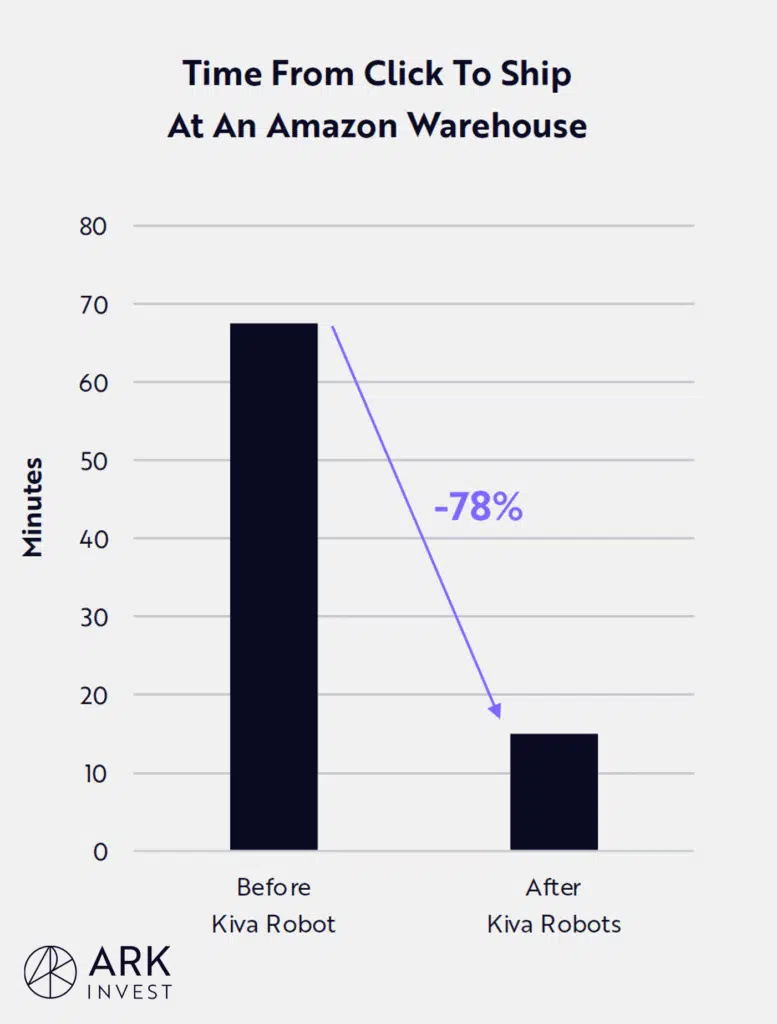
So the humanoids can work longer AND faster. Take both factors and you get more than ten times the work output of a human. Above all, this means that the costs of production and services, and therefore prices, will fall massively in the medium term. That is technical deflation. We will then be able to afford much more. That is productivity, which in turn leads to greater prosperity and quality of life.
Humanoid robots will not be in short supply
There is a global shortage of many millions of workers. And it is getting worse. Fewer and fewer people are willing to take on dull, dirty and dangerous work. Especially in production, trades, care and service, companies are having great difficulty finding enough workers. This is a threat to our prosperity. Humanoids will take on precisely the dull, dirty and dangerous jobs that fewer and fewer people want to do. It will be even more difficult in the future to find workers. Humans will then be able to do higher-value and more fulfilling tasks. Humanoids will be easy to buy. Humans will not.
MINUS arguments: no
Now to the minus arguments. What are the arguments against the physical capabilities of humanoid robots being sufficient for many millions of them to work for us?
Humans can do much more than robots
Yes, absolutely. Humanoids are far from having all the capabilities of humans. But they’re not supposed to have them anyway in the near future. Nobody is saying that they should or will completely replace humans. It’s enough that they work for us, first doing very simple tasks and then increasingly difficult and complex ones.
Many skills of the robots lie in the future
Yes, much of what I have mentioned as plus arguments is only partially a reality today. But this argument is weak, because the question here is whether millions or even billions of humanoid robots will work for us in the future, i.e. in the medium and long term. They don’t yet, but given their quickly evolving capabilities, they will. As I said, BMW wants to use the humanoid robot Figure in production, starting in 2025.
Humanoid robots could be too expensive
That could be the case, of course. There are no price lists yet. We will take a closer look at the financial arguments in the next article. Until then, we should assume that the immense capabilities of humanoids will offer enough benefits for manufacturers to invest and charge prices that cover their costs.
These are all minus arguments regarding the abilities of humanoids. There are many more minus arguments, but they do not relate to the physical capabilities of robots. We will analyze them in further articles.
Result
Okay, the question here is: will the physical capabilities of humanoids be so good that millions or even billions of them will work for us?
The result is pretty clear. Yes, humanoid robots with their physical capabilities will be able to do a large and growing proportion of work that was previously done by humans.
In the coming years and decades, humanoid robots will find their way into our working and living environments and change them dramatically. In terms of physical capabilities, there is hardly a strong argument against this assumption.
In the coming years and decades, humanoid robots will find their way into our working and living environments and change them dramatically. In terms of physical capabilities, there is hardly a strong argument against this assumption.
In another article, we will take a look at cognitive abilities. Will humanoid robots really be able to do what the Chinese government says, quote: think, learn and be innovative? AI is getting better and better every month. And is becoming the brain of humanoids. That’s the next big factor!
And yes, we will also look together at whether humanoid robots will be socially accepted at all, whether they will be profitable investment objects for companies and how they will be regulated. And I’ll give you guidance on how you can prepare yourself and your company for this future.
Links to the other robotics articles:
– Humanoid robots: will they be intelligent enough? (Part 2)
– Humanoid robots: how will they learn? (Part 3)
– Humanoid robots: how much will they cost? (Part 4)
– AI kills all jobs – and then what?
Three scenarios (Part 1)
– Prosperity through AI, but how? (Part 2)
Join our community called Bright Future Leaders. You are guaranteed to receive tips, hacks and strategies to make you and your company more future-proof. All for free. You can find the link here.
Have a bright future!
Placeholder





















